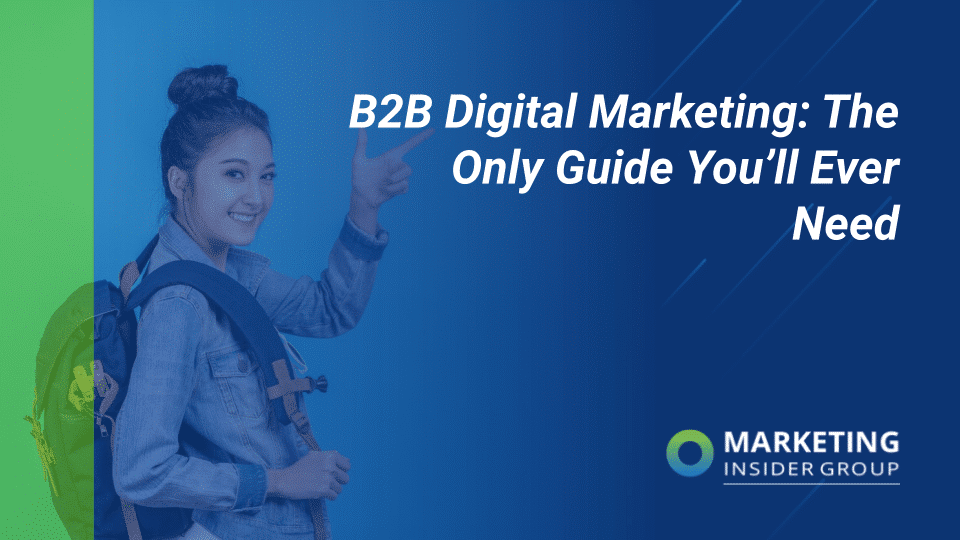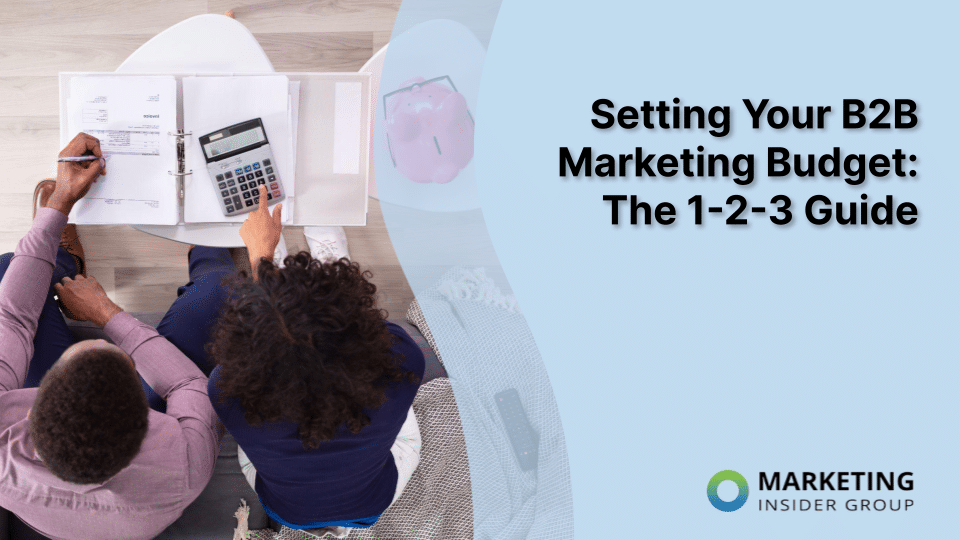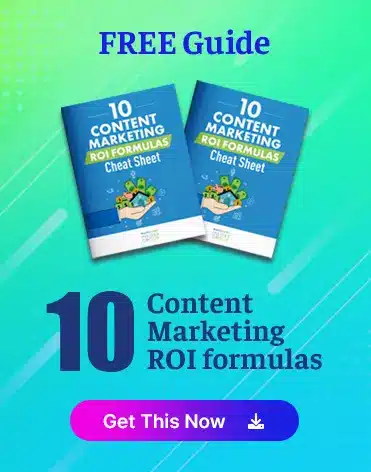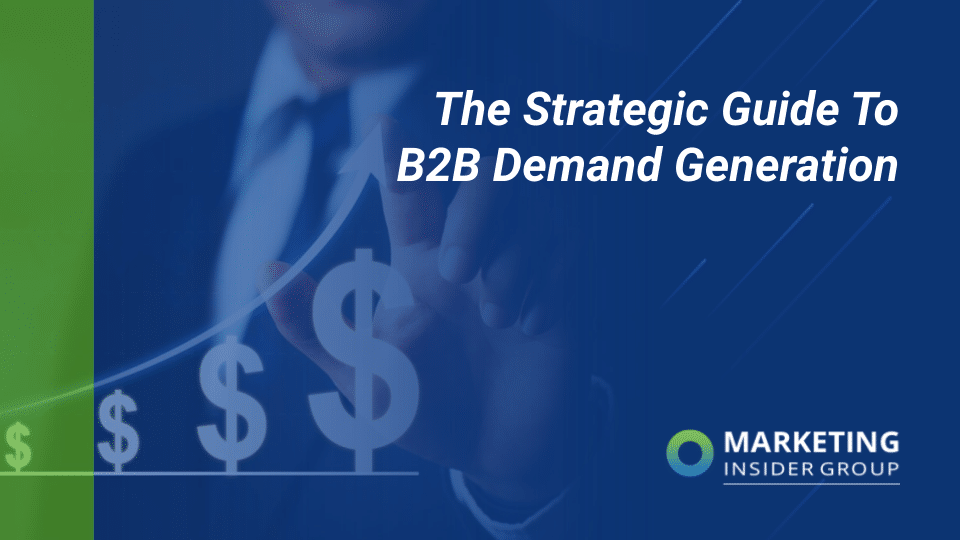
The Strategic Guide to B2B Demand Generation
Many marketers rely on demand generation to drive their business’s growth. In light of the current marketing landscape, many B2B companies are aiming to ramp up their efforts and build a strong customer base.
However, the effectiveness of demand generation lies in finding the right balance. When marketers fail to fit all the pieces together, their marketing tactics become a confusing mix instead of a well-crafted masterpiece.
Think of business growth as a machine.
To make your demand generation work smoothly, you need to create a consistent and appealing brand presence that draws in your audience. The only way to achieve this is by focusing on both short-term and long-term goals, and developing a well-rounded demand generation strategy.
Quick Takeaways
- Demand generation marketing tactics aim to create interest, engage the audience, and bring attention to your brand
- Creating a seamless customer experience involves aligning marketing and sales efforts, leveraging data, nurturing quality leads, and personalizing content
- Interactive content allows businesses to engage their target audience, create deeper connections with prospects, and foster long-term customer relationships
- Demand generation metrics help assess the effectiveness of campaigns and guide optimization decisions
Unlock the power of demand generation by understanding the customer journey, content marketing best practices, and data-driven decision-making.
What Marketing Tactics Are Part of Demand Generation?
Before getting into strategy, what are the puzzle pieces that make up this modern marketing approach?
Any marketing intended to create interest in a product or service is part of demand gen. This includes your:
- Content created to build or reignite interest, such as blog posts, podcasts, webinars, and event marketing.
- Social media engagement to generate buzz.
- Brand Storytelling and thought leadership
- Email marketing and marketing automation and customer delight tactics, intended to bring existing customers’ attention back to your brand.
McKinsey refers to the process of generating demand the consumer decision journey:
- The consumer has some kind of trigger event that propels them on a journey to solve a problem.
- Then they consider an initial set of brands.
- They evaluate what they want.
- They select a brand to work with.
- And they decide whether they like that brand and continue doing business with them
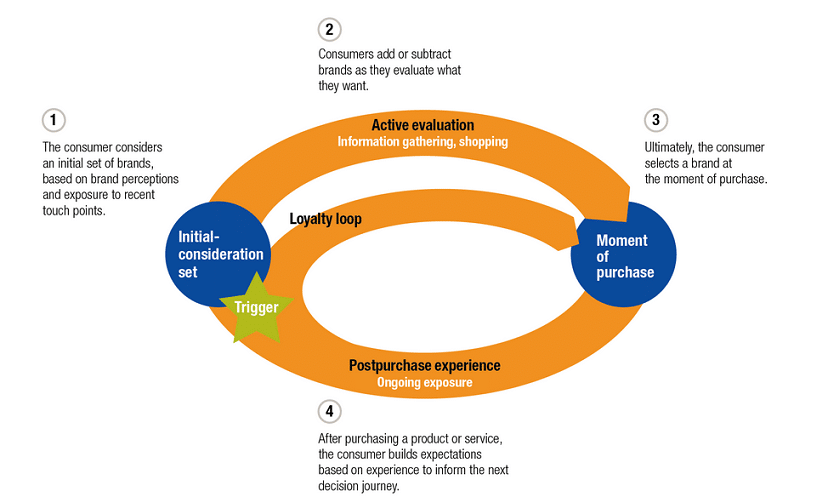
I find this model to be a complete over-simplification.
First of all, there is so much more that happens prior to the tiny little trigger point they represent as a star on their diagram. 90% of the buyer journey is complete before most buyers start thinking about brands. We can see this with search volumes. 2.8 billion searches for “content marketing.” 1.1 billion searches for content marketing agencies. But only 71 million searches for “Marketing Insider Group.”
Additionally, this consumer-centric model ignores the fact that 7-20 people are involved in the B2B buying decision. According to Gartner, the biggest gap in branded content is in what they call validation and consensus content. The CMO who wants to buy marketing automation needs to explain what it is to the CFO, the CIO, and 9 other people who aren’t in marketing.
Demand generation includes touch points along the entire customer decision journey, from prior to even having awareness of the problem, to purchase, and back around again in the (ideally) never-ending “loyalty loop” as my friend Andrew Davis calls it:
The difference lies in just generating B2B leads vs. managing your demand pipeline and helping your prospects buy.
This includes identifying those with a potential need, bringing in quality leads, and yielding breakthrough conversion rates.
And it is why a strategic mindset is key. Marketers need to be able to see seven steps ahead and around the curve as the customer journey cycles back.
How Demand Generation Works
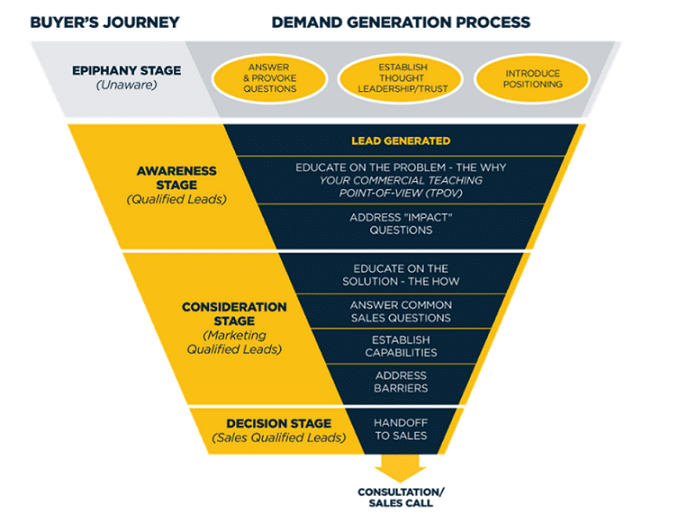
This is the recipe for successful demand generation:
- You must have a broad buyer perspective. What are their biggest challenges? What are the biggest trends in the industry?
- Collaboration between the marketing and sales team is critical in order to create an unbroken customer experience
- Lots of data helps to ensure quality lead identification and nurturing programs are in sync
These ingredients are then used to uncover the best prospects, narrow down leads and establish segments, and then customize content to create the most relevant brand experience for each segment.
Here’s a sample process to pull off demand generation strategically:
Step 1. Offer consistent and helpful content linked to premium content, discounts, promotions or other giveaways. Don’t just stick with one offer or one channel, such as only written content like eBooks and white papers on your website.
Use a variety of content types mapped to the customer journey to cater to different potential customers. Downloadable infographics, free trial periods, free apps or resources, or even promotional offers from relatable partner brands all help.
With every download, sign-up or other customer action, you’ll gain insight and have a better idea of which segments are interested in what and why.
Step 2. Offer more of a glimpse into your brand personality. Show your executives expertise in the form of keynote presentation videos. Talk to customers and show their personalities (not talking heads!)
This is the time for your content to form a more intimate connection with the customer. This tactic serves to invite them into a more committed brand-customer relationship.
Step 3. Differentiate inquiries from leads and please do not send inquiries to sales.
Whether it’s automated lead scoring, marketing automation nurturing, or human tele qualification, you must understand if your leads have the need, budget, and authority to make a decision in a timely manner. (We call this BANT.)
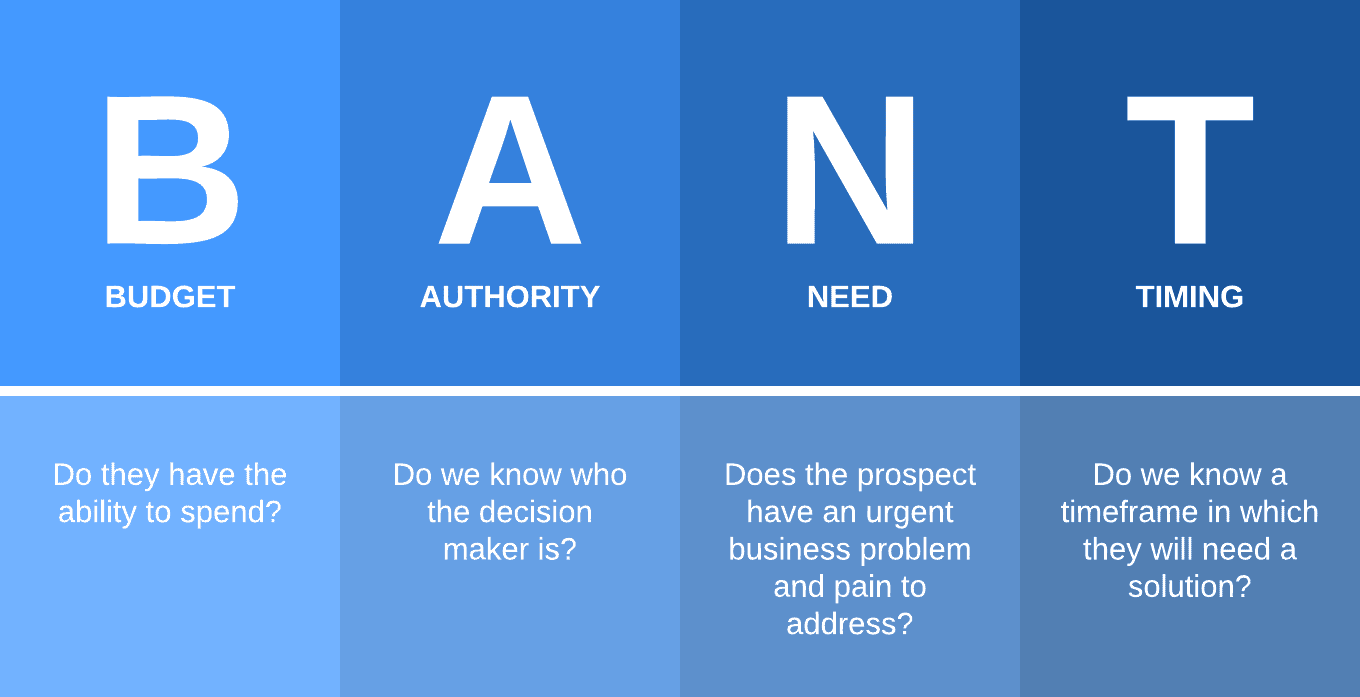
Step 4. Now is the time for tailored, worthwhile content that will convince your vetted leads to follow you along until a purchase is made. With demand generation, and account-based marketing, the idea is to keep the content coming while using tools like A/B testing and lead scoring to continually assess the effectiveness of your content and the quality of your leads.
Step 5. Keep engaging customers and leads with effective email marketing nurturing and deeper content experiences to keep existing customers up to date with new products, promotions, and content. Personalize content where and when you can.
All this, while you continue to focus your content marketing on gathering your next pool of prospects, ready to be identified, evaluated, thinned, and segmented.
The thread that keeps the long-term strategy together is to continue to further segment or refine your identified segments to engage only with customized content and offers a buyer is definitely interested in.
This allows marketers to focus on creating and investing in a high quality of content. You have a better idea of how effective it will be and for whom, as well as how it fits into the greater whole, which means more confident short-term campaign decisions.
This approach does require a concentrated, ongoing effort to stay focused on your quality leads and customer retention. But, as the nurturing process continues, relationships build, bonds thicken, and your pool of the highly qualified swells.
Who Is Responsible for Demand Generation? Marketing or Sales?
This seems to be the newest dilemma with any Demand Generation Program. In my 20 Years of experience with Sales and Marketing, I have been on both sides of the equation, and found that the optimal placement is… both!
Within every company, Demand Generation MUST align to the larger organization, I fully understand that, so I briefly discuss where and how Demand Generation should be aligned.
The Demand Generation Organization
Every organization is different and has many nuances including Product, Industry, Size. These differences will certainly have a substantial impact on how Demand Generation is aligned.
Whether it is a true Volume and Velocity Program, or a more Account Based Strategic Program, the answer is still the same, align the Demand Generation Group to the larger Sales Program. Sales has one major positive that Marketing typically does not, people (head count.) This will allow the Demand Generation team to scale as needed for the business, as Sales typically does not have an issue with adding talent as they are seen as “keeping the lights on” with the revenue Generation.
Demand Generation Management
Even with the alignment to Sales, the Demand Generation Team must function as its own entity within the organization. It must act as the conduit between Marketing and Sales. Too often the Sales Leadership “swallows” up the Demand Generation Group and makes it a “junior sales” team which only cares about revenue.
Subsequently, if aligned to Marketing too often the team becomes “event recruiters” or changes their primary focus to only driving qualified leads and pipeline. The Demand Generation Team’s primary role is prospecting, lead triage and opportunity generation, with secondary focus on revenue. To move away from this is to lose the efficiency and success of demand generation. Autonomy is key, and the demand gen team must always act for the overall success of the business.
KPIs for Demand Generation
This is a critical component for any team. Compensation dictates behavior. We want to be certain that our Demand Generation Team is fully focused on the goals, and the bonus is paid out accordingly. Sales accepted pipeline value and volume are the primary responsibilities and the bonus should be focused here. Revenue, qualified leads, system adherence should all be added as KPI’s, but only as a component of the position, they should not be a bonus factor, as they have the potential change the daily behavior of the marketing and sales team.
Teams and Roles That Are Critical for Demand Generation
Demand Generation is one of the most critical components of B2B Marketing. And yet, demand generation skills are rare in B2B Marketers.
The overarching goal of Marketing, Sales, or other functions involved in demand gen is to ensure consistency and growth in the sales pipeline. With this in mind, I believe in dividing up lead generation roles into four basic functions or themes:
- “Inbound” Lead Qualification: They qualify marketing leads coming inbound through the website or Contact Me Phone #. The sources of these leads are marketing programs, search engine marketing, or organic word-of-mouth.
- “Outbound” Prospecting: This function prospects into lists of target accounts to develop new sales opportunities. The Accounts can be a mixture of Prospect or Customer (for a new product). This is a team dedicated to creating and qualifying new sales opportunities that are passed to Account Executives to close.
- “Account Executives” are quota-carrying reps who close deals. This Team is best split by Inside Sales (lower revenue deals, Volume Velocity Markets) and Field Sales (High Revenue Deals, On Site visits). This Team is comprised of High Powered “Closers” that Manage pipeline and accelerate to Close.
- “Account Managers”: Client deployment and success, ongoing client management, and renewals. This is key for you to Protect your current Revenue streams as well as provide additional Customer References. A well taken Care of Customer is a happy customer
Demand Generation vs. Lead Generation
It’s important not to confuse demand generation and lead generation for the same strategy. Although they’re both key to growing your business, there are some differences to note when we talk about demand generation vs. lead generation:
Demand Generation
You already know that demand generation is about creating interest. It’s about getting people to notice your company’s products or services.
The main goal is to build a pipeline of potential customers by implementing activities like:
- Content creation
- Social media
- Advertising
- Events
- Webinars
The aim of demand generation is to educate prospects and make them interested in what the company offers.
Lead Generation
On the other hand, lead generation is a part of demand generation. It focuses on finding potential customers who have shown interest in your company’s offerings.
The main objective here is to collect prospects’ contact information and convert them into leads. This is done through methods like:
- Providing gated content
- Using web forms
- Landing pages
- Email marketing
- Webinars
- Collecting information at events
For lead generation, the goal is to gather contact details and qualify leads based on their potential as customers.
Is Demand Generation Synonymous with Digital Marketing?
Demand generation is simple. It is the act of generating demand for a product or service. But because it’s so simple, and encompasses everything from press releases to podcasts, utilized holistically over a long period of time, it’s also complex. It includes numerous techniques and strategies that need to be properly integrated in order to effectively translate the brand message to the consumer.
Marketing must be more than trade shows, logo colors and full-page ads. Marketing must drive sales for the business.
Demand gen is the marketing that generates buzz and awareness. While the focus is on lead generation, it also includes marketing to engage existing customers. What is distinct about demand generation is that it involves a long-term strategy and an integrated approach. Yes, cold calls and direct mailings, as well as your email newsletters and webinars are all a part of the demand generation show.
On their own, however, they are just pieces – a few lines spoken, an introduction. Demand gen is the whole performance. The stage, the props, the actors, the music.
Which brings us to inbound marketing and content marketing – those actors putting the demand gen show together, attracting attention, and delighting your audience.
Modern demand marketing has evolved so quickly over the past few years that we haven’t done the best job creating the constructive terminology to define what we’re doing.
Our innovation first, figure-out-how-to-explain-what-we’re-doing-for-the-benefit-of-others second approach has caught up with the digital marketing world – or should I say demand generation? Content marketing? Inbound?
It’s time to unravel this linguistic chaos and get out the Venn diagrams. There is a unique term for all the different approaches used in marketing because each is distinct in some way. Most overlap, which is where a lot of the confusion lies, and each has its own special sauce, or ‘reason to be.’ Otherwise, it wouldn’t exist in the first place.
Let’s attempt to understand the defining characteristics and strengths of each term:
Digital Marketing
Of all the types of marketing, digital is the broad umbrella term that encompasses them all. Any marketing or advertising delivered via a digital channel is digital marketing. It is all internet marketing, as well as SMS, the permission-based text messaging popularized by the evolution of fintech, and any digital TV and radio messaging.
Digital marketing has become such a powerful tool today because it allows marketers to meet consumers via their preferred channels. And, on a deeper layer, digital also dishes up the data, ready to be analyzed with all digital tools marketers have at their fingertips today. It is this data that helps marketers made better-informed decisions about what those preferred channels are, what messaging is effective, and what will improve the customer experience.
Deep into the digital era, marketers across the board, from small businesses to global brands, have already shifted from traditional to digital. 72 percent believe their branded online content is more effective than an old-fashioned magazine ad. 69 percent believe it’s better than direct mailings.
Internet Marketing
The terms internet marketing and digital marketing are often used interchangeably. For good reason – they are almost the same thing. Internet marketing is everything that digital is, minus anything that is not web-based, such as SMS and digital TV advertising. Both internet and digital marketing refer to all these tools and channels used today:
- Inbound marketing
- Content marketing
- Email marketing
- Social media
- Mobile marketing
- Banner ads
- SEO
- Pay per click advertising
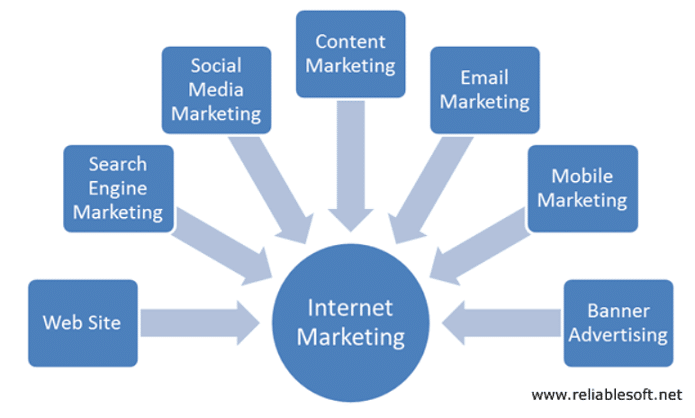
Internet marketing is a business’s search engine optimized landing pages, webinars, Instagram account, email campaigns and more. It (and digital) includes demand generation, inbound and content marketing.
While these three are primarily web-based, there’s a lot to these modern marketing strategies that can take place offline. Sometimes, they don’t always fall within the internet and digital marketing umbrella.
Inbound Marketing
The creators of inbound marketing software, Hubspot, are credited with coining the term. They define inbound as:
“Sharing is caring and inbound is about creating and sharing content with the world. By creating content specifically designed to appeal to your dream customers, inbound attracts qualified prospects to your business and keeps them coming back for more.”
The focus with inbound is on using content marketing to attract the best prospects and then to provide them exactly what they want as they move down the sales funnel. It involves a continual process of honing in on those buyer personas, segmenting when necessary, and delivering a personalized experience that makes leads and existing customers feel loved and wanted. It’s the type of marketing that you can’t do well without the organization, data analysis, and efficiency of a marketing software solution.
Inbound does include content marketing. In fact, Hubspot conducted a thorough survey, asking marketing professionals what they believed the relationship is between inbound and content marketing. The majority say that content is a subset of inbound. Looking at the relationship this way does make it easier to differentiate the two. Inbound includes all the different forms of content marketers can use to attract prospects and engage leads:
- Blog posts
- Newsletters
- White papers
- Social media posts
- Video content
- Podcasts
But it also refers to inbound strategies that don’t actually involve creating content – the biggest one being technical SEO. This includes fixing broken links, implementing meta tags, and other techniques.
Another helpful way to look at inbound marketing is to call it the flip side of outbound marketing. Outbound marketing is what we usually think of as traditional advertising – cold calling, fliers, telemarketing, radio/TV/print ads, direct mail – which are focused on projecting to your audience. The opposite, then, is finding ways to attract leads directly to your brand – i.e., inbounding them.
Content Marketing
Content marketing is a part of all the other marketing terms described above. It was around long before digital even existed (think Poor Richard’s Almanac). Content is created with the purpose of generating demand (demand gen), attracting prospects (inbound marketing), and ultimately driving sales. It focuses on offering value to the consumer and is a big part of the movement towards more meaningful brands.
It is frequently delivered through digital channels or online (digital and internet marketing) but content can be delivered in other ways, such as a speaking event or demonstration. It can be anything from industry interviews and white papers to what most people think of when someone says content marketing – brand blogs.
The Demand Generation Mix
Even though these marketing strategies overlap quite a bit, it’s important to understand the scope of each type of marketing. By seeing each for what it can individually contribute towards your overall campaign, you cultivate the advantages it offers.
You need content’s establishment of trust and brand authority. Inbound’s excellence in giving your audience exactly what they want and always refining the buyer experience. Demand generation’s long-term mindset that brings content, inbound, and even outbound together. And a digital and internet marketing ethos to broaden the scope even more, focusing on innovative digital tools and the use of data to constantly improve.
And, isn’t that the point of coming up with all these offshoots and evolutions of the same core? We’re always looking for a better way to reach the consumer. This is because we know there always is one ready to be reached.
10 (or so) Ways to Ace Demand Generation
Companies that have the resources may be using fantastic AI-informed social media marketing campaigns and interactive brand apps to create demand for their products and services. While cutting-edge demand generation techniques are great, especially in response to the modern marketer’s dual challenge of higher customer expectations and higher C-suite expectations, the tried and true, very budget-friendly methods are still just as crucial for your marketing strategy.
1. Publish Content that Address Your Customers’ Questions and Problems
For B2B companies, demand generation involves offering a very professional level of content to appeal to prospects. Software company Atlassian does an excellent job of drumming up interest when a site visitor lands on their page.
From hello, (landing on the homepage), the company offers different choices to capture interest. An introductory video, an infographic with more tailored content, a free trial offer, and a downloadable guidebook. What a prospect chooses indicates their level of interest in Atlassian’s products.

Your organization’s blog isn’t just for driving traffic to your site. It has the potential to be your brand’s most powerful demand generation asset. The difference between blog content that engages and one that creates demand lies in relevancy to your audience.
An effective process to use for your content schedule is to follow the buyer’s journey. Publish content that fulfills the awareness and consideration stage in order to bring leads along to the decision stage and attain the ultimate goal of revenue growth.
Make sure your posts are answering questions that are specific to your market. Tools like AnswerThePublic and Quora are fantastic for guiding solution-oriented content. It’s also wise to keep track of client questions you may find pop up on forums and social platforms for your industry, communications to your sales department, as well as questions on customer feedback channels such as surveys and reviews.
2. Scale Up and Connect with Interactive Content
Content marketing is the foundation of your demand generation. If you want to create lava-hot demand, welcome your target customers into your world with interactive content. From industry conferences to educational webinars, when you motivate people to invest their time and energy into your brand, you’re on your way to rock solid customer relationships.
Even if you don’t have the budget to pull-off a big in-person event, with the technology available today, a webinar can fit comfortably into any sized budget. You can expect to convert anywhere between 20 and 40 percent of your attendees into qualified leads.
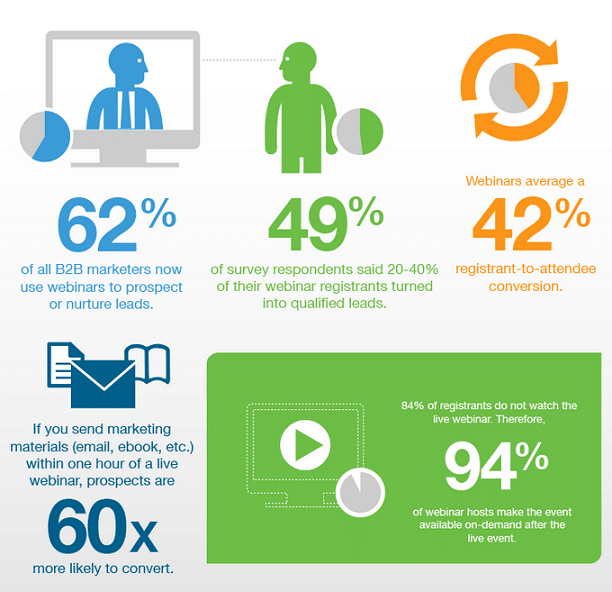
Webinars are one of the best demand gen tools out there because when a prospect or customer signs up, they are making a commitment to continue the brand relationship at some point in the future. They become vested.
Tip for webinar success: offer regular webinars or create webinar series. When your potential buyers know more online events are coming up, they may keep your brand in mind, follow you on social media, or sign up for your newsletters.
3. Send Emails that Your Contacts Want to Open
When it comes to your email marketing, keeping your audience engaged isn’t the easiest thing in the world. There are a few steps you can take to make your emails a more welcome addition to your customers’ inboxes.
- If your email open rates aren’t high, try further segmenting your contact lists so you can offer better-personalized content. For example, consider segmenting based on interest level, number of purchases, the length of the customer relationship, level of customer satisfaction, specific products or services they are interested in, as well as demographics.
- Make sure you are building a list of people who want to hear from you. Tactics like a double opt-in at subscription and letting go of your contacts who aren’t ever opening your emails anyway will give you a clearer idea of what you’re working with. A shorter list of interested contacts will help you better tailor your messaging.
- Vary your offerings. Coupons and discounts, sign up for your next event or webinar, a link to your brand’s hysterical marketing video – train your contacts to expect the works when they open your emails.
4. Send Emails that Your Targets Actually Read Through and Act On
In over 20 Years of Lead Generation, I have found that if you follow these hints Emails Do Work (9+% Conversion)
- No Sales Pitch: This is the most common mistake today, “Do you have these Challenges?….”, “Let us help you solve this problem…”, “ Our Product can do this for you…” These Emails are boring, they sound like the other 15 he received that day and will not generate you a response, especially from the C Suite. This is like meeting someone for a first date and leaning in for the kiss before you say “Hello”. Be patient !
- Be Specific: Keep the Email Short and Sweet. You have roughly 5-8 Seconds to grab someone’s attention and Paragraphs clearly have the opposite effect. Use strong simple statements.
- Referrals are the Key: Especially if you target the C-Suite You should be asking for one thing, A “Referral” to the correct person within the Company. The most difficult thing in Prospecting is finding the correct person to speak to, so let your Email do it for you. The trick here is to be specific enough about who you need to speak to but not selling your product or service
5. Generate Leadership- and Education-Focused Content
We no longer put together a 3-page article talking about how great XYZ product is. Buyers are overwhelmed with options and want somebody that can help them solve an immediate problem, creating content along this framework goes a long way. When somebody is seeking out the equivalent of “How to put together a power wheel” (when they’ve lost the instruction manual) the last they want to see are articles talking about how fast the jeep can go.
The same applies to tech buyers. We have problems (that we might not even be aware of), and we want to be understood and provide a solution – not pitches with cluttered information.
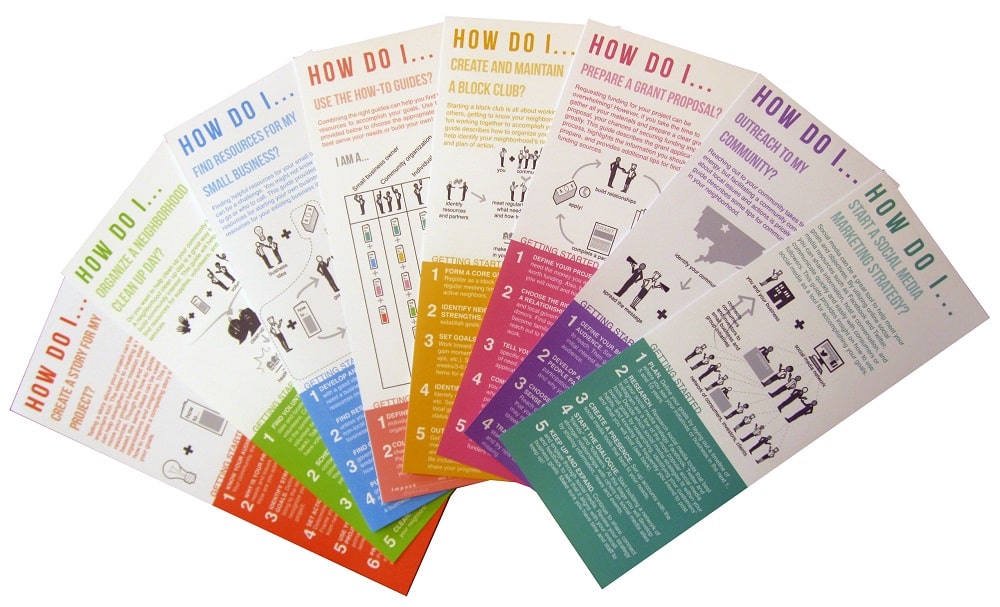
So instead of a product plug, spend some time thinking about what causes a buyer to start researching similar products to yours. Develop a piece of content about different ways that problem can be solved, in which coincidentally your product happens to be a part of.
6. Know Your Sales, BDR, and Funnels to Decide Which Strategies Make Sense
If you have a team of BDRs that isn’t expecting you to hand them ready to book appointments and know it will take upwards of 7+ touches to get any sort of response, then use data assets like; intent data and other combinations of firmographic and behavioral based targeting to get you in the right ball park. From there, let them execute their prospecting at scale and cost effectively book you meetings.
Ditto if you have a great converting nurture track built out. Find the highest quality that combines persona based targeting and intent data so you can cost effectively funnel those buyers. Finding buyers with highest propensity in the early stages gives you the opportunity to sort out prospects pain points and provide solution.
7. Validate BANT Lead Qualifications?
BANT is a super effective way to qualify leads. One caveat: make sure the criteria you set up is verified.
Vendors and BDRs will want to say leads are BANT-qualified only for your AE to reject them.
Make sure there is data and verification along the way and reward any on the lead qualification process with validated lead scores.
8. Beef Up Your Social Engagement
One of the best ways to create demand will always be through social proof. You may not be in a position to partner with a social media celebrity, but the opinion of your actual customers carries a lot of weight with your potential ones. 85 percent of consumers pay attention to reviews for local businesses and 73 percent say positive reviews helps to build trust.
Don’t be afraid to reach out to your best customers and ask them to write a review. Encourage social sharing of your brand by offering customers something in return for posting about their experience on Twitter or sharing a snap of your product on Instagram.
Here’s an example from Tide, using Twitter to drum up some demand generation with existing customers. What an excellent way to attract buyers back to Tide. Specifically targeting the customers who may be tempted to abandon ship if they choose to look elsewhere for more eco-friendly laundry products, a competitive advantage Tide is not known for. And, the brand’s marketing team uses a bit of well-played influencer marketing with actress Kristen Bell as a face for the campaign.

How are your customer testimonials doing? Do you only have a few outdated quotes on your website? Do you have photos or videos to make your testimonials appear more authentic? Are you sharing client case studies within your business’s blog and LinkedIn posts?
9. Make it Fun
Even though its B2B and you will see 100 posts of “this is not Facebook” on LinkedIn, at the end of the day you still need PEOPLE to engage with you.
That happens much easier when you can break down barriers and connect on a somewhat personal and authentic level. Nobody wants to “create synergies” but you can bet they 100% want to walk into that meeting with their boss and tell them how they finally figured out this issue that has been talked about in meetings for weeks. Don’t be afraid to put down the B2B dictionary of extremely inauthentic phrases and jargon and personalize your outreach and content to resonate with your audience.
10. Be Certain Your Sales Process is Pulling Your Prospects Not Pushing
Sales People need to be Patient, move at the Prospects pace not yours:
Sales Stages: Critical to have a fully developed Sales Process with Milestones. Analyze your Data to understand the typical Sales cycle and Benchmarks, Discussion, Demo, On Site, Contracts etc..
Be Flexible: Remember no two deals are alike so you have to be able to move as the Prospect wants. Some like to move slower than others so you need to be adaptable to that. Never tell the Prospect the Next Step, ask Him or Her, what they would like next. Prospects prefer to feel like they are in control.
How to Measure the Success of Your Demand Generation Efforts
The best way to measure the success of Demand Generation efforts is revenue! This is the literal Value of the leads generated.
While Revenue may be difficult and there may be lots of great reasons why this can be challenging (systems, process, people), this should be the goal: to measure revenue that directly results from demand generation spend. This can be expressed as either a dollar amount, a percentage or an index.
Now if that is literally impossible for some companies, the next most important metric is the Pipeline Value of the Opportunities created directly from demand generation spend. Pipeline value can be a helpful metric where the deal cycles are long, as they are in most B2B Marketing organizations. You can use this metric to make “in-flight” optimization decisions of a campaign as pipeline value should be identified relatively quickly in a demand generation process.
Other metrics to use include what is commonly referred to as the “3 V” approach. The 3 Vs are:
- Volume (Impressions, Clicks, Registrations, MQLs, SQLs, Opportunities, Deals)
- Velocity (conversion rates from each unit above to the next level)
- Value (mentioned above: revenue and pipeline)
Some organizations may also add a 4th “V” called “Viscosity” which can measure the obstacles or friction to rapid conversion from one lead stage to another. Viscosity is generally more specific to marketing tools, infrastructure, process and training issues as opposed to the actual value of demand generation.
Over to You
Demand generation a long-term game that requires a jigsaw puzzle strategy. Integrating technology intelligently into your organization in order to create a “Demand Factory,” as David Lewis of Demandgen coins it, requires a resources investment, a commitment to change management and an innovative, flexible organizational mindset.
While long-term goals of the elegant use of marketing automation and tomorrow’s martech tools should be on every marketer’s radar, just because you can’t leap forward into the future of marketing right now, doesn’t mean you shouldn’t at least step forward with the classic demand generation techniques that we all know work. Just remember these basics:
- Content that solves problems for your audience will build trust and authority for your brand.
- A formulaic approach to lead generation won’t get you anywhere.
- Even if you’re in a B2B industry, make every interaction with prospects and customers fun and authentic.
Ready to give your marketing strategy a boost? Start by creating high-quality content consistently. Get started today by checking out our weekly blog content service, or schedule a free consultation now to learn more!


